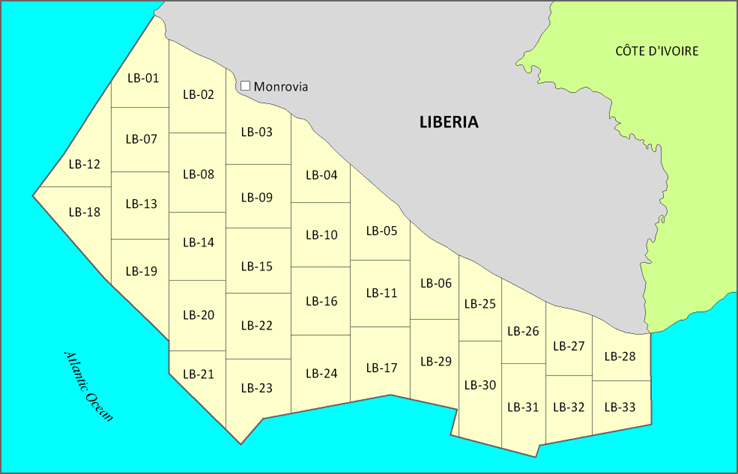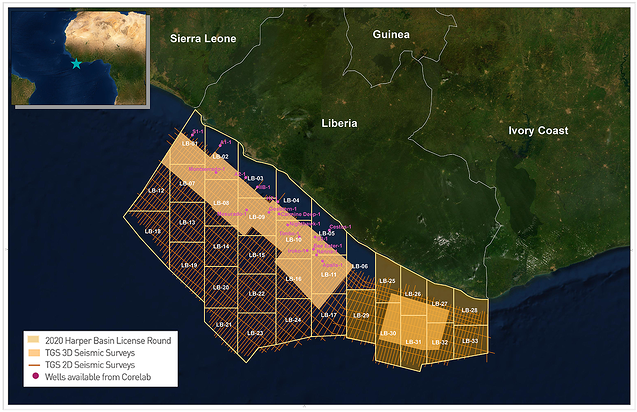
The Liberia Basin consists of thirty three concessionary blocks. 17 of these blocks are from the continental shelf to water depths of between 2500 to 4000 meters. 13 of the blocs are considered “ultra deep” with water depths of as much as 4500 meters. (Map source: KeyFacts Energy)
The Liberia Basin consists of thirty three concessionary blocks. 17 of these blocks are from the continental shelf to water depths of between 2500 to 4000 meters. 13 of the blocs are considered “ultra deep” with water depths of as much as 4500 meters.
Liberia is a country that resumed stable and democratic government in 2006, after a period of over twenty years of civil war. The current government, which is underwritten by the United Nations (“UN”) and the USA, has restored democracy and through its government agency, National Oil Company of Liberia (“NOCAL”), is directing efforts towards the opening of the natural resource sector to foreign investment, and consequently, is also laying great emphasis on infrastructure. The Liberian and US dollar are freely traded in parallel within the national economy.
Liberia does not have a well-developed upstream oil and gas industry. Hydrocarbon exploration activities in the Liberian territorial waters started in the late 1960s, but those activities ceased due to a variety of factors including civil unrest and political instability.
Liberia has a number of offshore oil blocks some of which have been licensed to multinational oil companies. The blocks are from the continental shelf to water depths of 2500-4500 meters, and exploration activities require multi-million dollar investments. Expectations for significant offshore oil discoveries became high as a number of international oil companies - such as Anadarko Petroleum, African Petroleum, Chevron and ExxonMobil -signed productions sharing contracts (PSC) with the Liberian government. Although some of these companies subsequently began exploratory drilling, none has yet reported commercially viable oil deposits.
Country Key Facts
- Official name: Republic of Liberia
- Capital: The capital city is Monrovia; it covers an area of 13.7 square miles (35.5 square kilometres) and has a population of 36,713 (2018).
- Population: 4,940,208 (2019)
- Area: 43,000 sq miles, 111,370 sq kilometers
- Form of government: Republic
- Language: English
- Religion: Indigenous beliefs, Christian, Muslim
- Currency: Liberian dollar (LRD)
- Calling code: +231
History
Liberia (the Republic of Liberia) is bordered by Sierra Leone (west), Guinea (northeast) and Côte d'Ivoire (east). The Gulf of Guinea of the Atlantic Ocean runs along the southeastern coastline.
Records of people in Liberia go back to the 12th century when Mende people moved west from Sudan forcing smaller groups to the coast, especially as the Mali Empire collapsed. Tribes traded along the coast and slave-trading Arabs also arrived. From 1461 Europeans developed trading posts, naming it the Pepper Coast, and then the Grain Coast.
In 1822 the American Colonization Society began sending thousands of freed black Americans to settlements in Liberia. The new arrivals believed in western politics, subjugating the indigenous tribes. Never colonised by Europeans, they declared independence in 1847 as Africa's first republic.
However, lack of investment and loss of territory to neighbours caused the economy to struggle. In World War 2 Liberia supported the USA who invested in infrastructure and the country grew strongly until a military coup in 1980 by the Krahn tribe. Two civil wars then devastated the economy. Recovery only began after a peace agreement in 2003.
Offshore License Round 2020
The Liberia Offshore License Round 2020 has been formally launched and will run to February 28, 2021.
The Harper Basin offers significant exploration potential in one of the few remaining unexplored deep-water basins in West Africa. The initial interpretation of 2D and 3D seismic data identifies many leads and prospects across the entire basin. Several sub-commercial discoveries from previous wildcat wells in the Liberia Basin have proven that the petroleum systems are working offshore Liberia. Recent discoveries offshore Cote d’Ivoire prove source maturity, the viability of the reservoir quality, and charge potential of commercial size. The Albian reservoir offshore Cote d’Ivoire, for example, is producing and considered a good analogue for the maturation story and identified traps in the Harper Basin.

Map source: TGS
The round is being launched in parallel with attractive amendments to Liberia's Petroleum Law, following major regulatory changes in October 2019, and the extension of the exploration period, in order to attract international investors.
The Liberia License Round, 2020 will be conducted through three main stages: Pre-qualification, Bid Submission, and Bid Evaluation/Award.
Nine blocks will be on offer in the Harper Basin, one of the last unexplored and undrilled regions offshore West Africa: LB-25, LB-26, LB-27, LB-28, LB-29, LB-30, LB-31, LB-32, LB-33. The new block demarcation is following the petroleum bill update in 2019, with a maximum block size of 3,500 square kilometers, and aligning with the longitude and latitude grid.
TGS holds a range of multi-client data across the tendered acreage to support the licensing round:
- 5,961 kilometers of 2D seismic, gravity and magnetic data
- 6,167 square kilometers of 3D seismic, gravity and magnetic data
Geological Insight into the Harper Basin
- The geological evolution of offshore Liberia is related to the opening of the Atlantic Ocean.
- The Harper Basin offers significant exploration potential, being the last real frontier basin of West Africa.
- Several sub-commercial discoveries have proven that the petroleum systems are working offshore Liberia.
- The Harper Basin has a petroleum system analogous to surrounding basins associated with the recent discoveries in Ghana, Cote d’Ivoire and also the conjugate Guyana.
Ministry of Lands, Mines & Energy
The Ministry of Lands, Mines & Energy (MLME) was established by an act of Legislature to administer all activities relative to land, mineral, water and energy resource exploration, coordination and development in the Republic of Liberia.
The Department of Energy (DOE) is the arm of the Ministry which is charged with the responsibility to govern and oversee the management of the Nation’s Energy resources; DOE also coordinate stake holders’ actions in the energy sector of the Republic of Liberia.
The Department of Energy comprises of two bureaus:
- The Bureau of Hydrocarbon
- The Bureau of Alternative Energy
Ministry of Lands, Mines & Energy
Buzzi Quarter, Capitol Hill, P. O. Box 10-9024 1000Monrovia, 10 Liberia
Tel: (+231)886546258 (Administrative)
Tel: (+231886125659 (Exploration)
www.molme.gov.lr
The National Oil Company of Liberia
The National Oil Company of Liberia (NOCAL) was established in April 2000, by Liberia’s National Legislature.
The company is responsible for the rights, titles and interests of the Republic of Liberia in the deposits and reserves of liquid and gaseous hydrocarbons within the territorial limits of the Republic of Liberia, whether potential, proven, or actual, with the aim of facilitating the development of the oil and gas industry in the Republic of Liberia.
Company and Country Reports
KeyFacts Energy now provide bespoke reports covering selected country and energy company 'at-a-glance' reviews, allowing users to access valuable 'first-pass' information ahead of more detailed analysis.
Contact us for further information.
 KEYFACT Energy
KEYFACT Energy